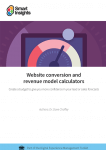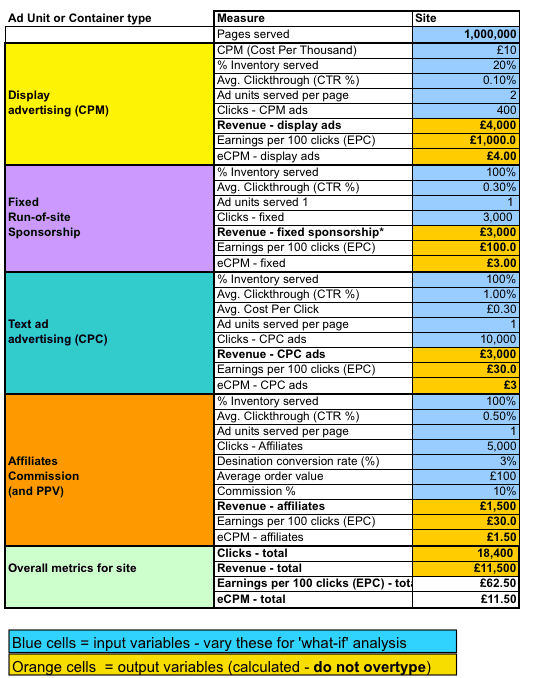Selecting the best revenue options for Internet startups
I’m often contacted by site owners with an idea for a new site who are trying to work out how much revenue they’ll be able to raise depending on the number of visitors to their site.
There’s no simple answer to this, but to help, several years ago I created this spreadsheet model which also features in my books as an activity to help students working on this topic. It shows the main parameters you need to set (blue fields) and it works out the revenue earning (orange fields).
The Site Ad revenue model
If you plug in some average figures for pay-for-performance-based advertising options like cost per click or cost per action approaches, as shown below, it shows why fixed fee and CPM models tend to be preferred by publishers.
It also shows that you need substantial traffic to make much money through advertising. At a CPM Of £10 with 2 ad units on the site, you would make just £4,000 per month even with a million page views per month for which you serve paid ads to 20% of the audience. Set this to 100% if you are selling all your ad inventory, as for example through Google Adsense.
To use this model and different Internet site revenue models to calculate income potential use our online revenue model spreadsheet - see Ad Revenue model worksheet. This includes a range of Internet planning models including a way of assessing Internet revenue sources - this is on worksheet 3.
How to use the revenue model calculator
This spreadsheet can also be used by owners of existing sites like publishers to estimate ad or affiliate marketing revenue from a site or section of site.
It allows these parameters to be set:
- % inventory - proportion of ad space sold on sites
- Number of ad units
- CPM - Cost per thousand impressions for ad volume deals
- CPC - Cost Per Click for Pay Per Click Deals
Total revenue for each ad unit or container and corresponding Earnings per 100 clicks (EPC) or Earnings per thousand page views (eCPM) are calculated automatically.
The limitation of the model is that it assumes the same model across the whole site. It would be straightforward to modify it for different sections.
The 8 Internet revenue model options
For a publisher or other media site owner, I would identify eight types of revenue model, which are possible online. Let me know of any I’m missing 
Of course, transactional sites have the option of these also in addition to sales - online, everyone is a media owner.
1. Revenue from subscription access to content
A range of documents can be accessed for a period of a month or typically a year.
For example, I subscribed to FT.com for access to the digital technology section for around‚ 80 GBP per year a few years ago. Smart Insights Expert members have an annual subscription in this form.
2. Revenue from Pay Per View access to document
Here payment occurs for single access to a document, video or music clip which can be downloaded. It may or may not be protected with a password or Digital Rights Management.
For example, I’ve paid to access detailed best practice guides on Internet marketing from Marketing Sherpa.
Digital rights management (DRM) The use of different technologies to protect the distribution of digital services or content such as software, music, movies, or other digital data.
3. Revenue from CPM display advertising on site
(e.g. banners ads and skyscrapers).
CPM stands for “cost per thousand” where M denotes “Mille”. The site owner such as FT.com charges advertisers a rate card price (for example 50 GBP CPM) according to the number of its ads shown to site visitors. Ads may be served by the site owners own ad server or more commonly through a third-party ad network service such as Google AdSense as is the case with my site.
4. Revenue from CPC advertising on site (pay per click text ads)
CPC stands for “Cost Per Click”. Advertisers are charged not simply for the number of times their ads are displayed, but according to the number of times they are clicked. These are typically text ads similar to sponsored links within a search engine but delivered over a network of third-party sites on a search engine such as the Google Adsense Network.
Typical costs per click can be surprisingly high, i.e. they are in the range GBP 0.10 to “‚ GBP 4, but sometimes up to GBP 40 for some categories such as "life insurance” that have a high value to the advertiser.
The revenue for search engines or publishers from these sources can also be a fair proportion of this.
Google Network Revenues through Ads generate around 88% of Google’s revenue. For me, the Google’s content networks are one of the biggest secrets in online marketing with search engines such as Google generating over a third of their revenue from the network, but some advertisers not realizing their ads are being displayed beyond search engines and so not served for this purpose.
Google is the innovator and offers options for different formats of ad units including text ads, display ads, streamed videos and now even cost per action as part of its pay per action scheme.
5. Revenue from Sponsorship of site sections or content types (typically fixed fee for a period)
A company can pay to advertise a site channel or section. For example, bank HSBC could sponsor the Money section on a media site. This type of deal is often struck for a fixed amount per year. It may also be part of a reciprocal arrangement, sometimes known as a “contra-deal” where neither party pays.
A fixed-fee sponsorship approach was famously used by Alex Tew in 2005, a 21-year-old considering going to University in the UK who was concerned about paying off his university debts. This is no longer a concern since he earned $1,000,000 in 4 months when he set up his Million Dollar Homepage.
His page is divided into 100-pixel blocks (each measuring 10x10 pixels) of which there are 10,000 giving 1,000,000 pixels in total. Alex spent £50 on buying the domain name (www.milliondollarhomepage.com) and a basic web-hosting package. He designed the site himself but it began as a blank page.
6. Affiliate revenue (CPA, but could be CPC)
Affiliate revenue is commission based, for example, I display Amazon books on my personal blog site DaveChaffey.com and receive around 5% of the cover price as a fee from Amazon. Such an arrangement is sometimes known as Cost Per Acquisition (CPA).
Increasingly, this approach is replacing CPM or CPC approaches where the advertiser has more negotiating power. For example, in 2005 manufacturing company Unilever negotiated CPA deals with online publishers where it paid for every e-mail address captured by a campaign rather than a traditional CPM deal.
However, it depends on the power of the publisher who will often receive more revenue overall for CPM deals. After all, the publisher cannot influence the quality of the ad creative or the incentivization to click which will affect the Clickthrough rate on the ad and so the CPM.
7. Subscriber data access for e-mail marketing
The data a site owner has about its customers is also potentially valuable since it can send different forms of e-mail to its customers if they have given their permission that they are happy to receive an e-mail either from the publisher or third parties. The site owner can charge for adverts placed in its newsletter or can deliver a separate message on behalf of the advertiser (sometimes known as list rental). A related approach is to conduct market research with the site customers.
8. Access to customers for online research
Considering all of these approaches to revenue generation together, the site owner will seek to use the best combination of these techniques to maximize the revenue. To assess how effective different pages or sites in their portfolio are at generating revenue, they will use two approaches. The first is eCPM, or effective Cost Per Thousand.
This looks at the total they can charge (or cost to advertisers) for each page or site. Through increasing the number of ad units on each page this value will increase. This is why you will see some sites which are cluttered with ads. The other alternative to assess page or site revenue generating effectiveness is Revenue per click (RPC), which is also known as Earnings Per Click (EPC).
This is particularly important for affiliate marketers who make money through commission when their visitors click through to third-party retail sites such as Amazon and then purchase products.
from Blog – Smart Insights https://www.smartinsights.com/digital-marketing-strategy/online-business-revenue-models/online-revenue-model-options-internet-business/
via Tumblr http://euro3plast-fr.tumblr.com/post/168496838664


No comments:
Post a Comment